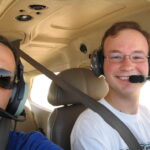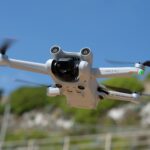Your Ascent to the Skies: Top Online Commercial Pilot Training Program & Courses
Embarking on the journey to become a commercial pilot is an exhilarating adventure, one that opens up the skies to endless possibilities. With the right training, you can transform your dreams of flight into reality. The convenience and flexibility of online commercial pilot training programs have made it easier than ever to start this journey. Let’s navigate the essentials of choosing the best online program to set you on the right trajectory for your aviation career.
Key Takeaways
- Understand the benefits of online commercial pilot training programs.
- Discover the key factors to consider when selecting an online flight school.
- Explore the core curriculum components of top-notch online pilot training.
- Learn about the essential flight maneuvers and procedures every pilot must master.
- Gain insights into how online training can effectively prepare you for real-world flying.
Choosing Your Flight Path
Choosing the right training program is the first crucial step in your aviation journey. It’s about finding a balance between a comprehensive curriculum, experienced instructors, and the flexibility to learn at your pace. The program you select should not only prepare you for the FAA exams but also equip you with the skills needed for a successful career in the skies.
The Rise of Online Pilot Education
Online pilot education has soared in popularity, offering a level of convenience that traditional flight schools can’t match. Imagine learning the principles of flight from the comfort of your home, or revisiting complex concepts as often as you need. This flexibility allows you to fit your passion for flying into your busy life, without compromising on the quality of your education.
Criteria for Selecting the Best Program
When it comes to choosing an online commercial pilot training program, there are several criteria you should consider:
- Accreditation: Ensure the program is recognized by aviation authorities.
- Curriculum: Look for a comprehensive course that covers all necessary topics.
- Instructor Expertise: Qualified instructors are crucial for a solid learning experience.
- Technology: The program should use the latest tools and simulators for effective learning.
- Flexibility: Choose a course that fits your schedule and learning pace.
- Support: Good programs offer robust student support and resources.
- Success Rate: Check the pass rate of students who have completed the program.
Wings of Knowledge: Core Curriculum Insights
The core curriculum of a top online commercial pilot training program forms the backbone of your education. It should cover all the theoretical knowledge required by the FAA, from aerodynamics to aviation regulations. But it’s not just about passing exams; the curriculum should also lay a strong foundation for practical flying skills.
Fundamental Flight Maneuvers and Procedures
Mastering the art of flying starts with understanding the fundamental maneuvers and procedures. These are the building blocks of all future flight training and operations. A good online program will not only teach you these concepts but also show you how they are applied in real-world scenarios, often through high-quality video tutorials and interactive simulations.
Here’s a glimpse of what you’ll learn:
- Takeoffs and landings: The techniques for safe and smooth operations.
- Navigation: Using both traditional and modern avionics to find your way.
- Emergency procedures: Preparing for the unexpected with confidence.
- Aircraft systems: Understanding how your aircraft works from the inside out.
- Communication: Effectively communicating with air traffic control and other pilots.
With these skills in your logbook, you’ll be well on your way to reaching new heights in your pilot training journey. Stay tuned as we continue to explore the exciting world of online commercial pilot training and how it can help you achieve your dreams of flight.
Mastering Weather and Environmental Challenges
Weather can be a pilot’s greatest ally or most formidable foe. A top-tier online commercial pilot training program teaches you to interpret weather data accurately, make informed decisions, and handle the challenges that come with different environmental conditions. Understanding weather patterns, cloud formations, and how to navigate through adverse conditions is not just about safety; it’s about gaining the confidence to take on the skies, no matter what they throw at you.
- Reading and understanding METARs and TAFs: Decoding the codes that describe weather conditions.
- Weather radar: Interpreting the screen to stay ahead of the storm.
- Dealing with turbulence: Keeping a cool head and a steady hand when the ride gets rough.
- Ice and snow: Recognizing the risks and knowing how to mitigate them.
- Heat and high density altitude: Adapting your flight planning and performance expectations.
High-Altitude Systems and Performance
As you climb higher, the air gets thinner, and the demands on both pilot and machine increase. Your training program should cover the intricacies of high-altitude flight, from oxygen systems to pressurization. You’ll learn about the physiological effects of flying at altitude and how to optimize your aircraft’s performance in the thinner air found at higher elevations.
- Oxygen systems: Understanding the how and why of supplemental oxygen.
- Pressurization: Keeping the cabin comfortable and safe.
- High-altitude aerodynamics: How flight characteristics change as you ascend.
- Performance calculations: Adjusting for reduced air density and its impact on your aircraft.
Navigating the Digital Classroom
The digital classroom is where your aviation dreams take flight before you ever leave the ground. It’s a space where technology and education converge to provide an immersive learning experience. Navigating this environment is about more than logging in; it’s about leveraging the tools and resources available to maximize your learning potential.
Interactive Tools and Simulations
Interactive tools and simulations are the heart of online pilot training. They bring the thrill of flying into your home and allow you to practice scenarios that you’ll face in the cockpit. From virtual flights to system management, these tools offer a hands-on approach to learning that reinforces your theoretical knowledge and prepares you for actual flight training.
- Flight simulators: Practicing maneuvers without leaving the ground.
- Interactive diagrams: Exploring aircraft systems with a click.
- Scenario-based training: Making decisions based on simulated real-world situations.
- Virtual reality: Immersing yourself in a 360-degree flight environment.
Support and Resources for Online Learning
Support and resources are the backbone of any successful online learning experience. They provide the guidance and assistance you need to navigate the coursework and prepare for exams. Look for programs that offer comprehensive study materials, access to instructors or mentors, and a community of fellow students to engage with. The support you receive can make all the difference in your training journey.
- Study guides and textbooks: Your written companions in the learning process.
- Webinars and live sessions: Real-time interactions with instructors and peers.
- Discussion forums: Sharing insights and asking questions in a collaborative online space.
- Personalized feedback: Tailored advice to help you improve your skills.
Flight School Partnerships
While online courses offer a solid foundation in aviation theory, the practical skills of flying are honed in the cockpit. This is where partnerships between online training programs and flight schools come into play. These collaborations are designed to bridge the gap between online learning and in-person flight hours, providing a seamless transition from the virtual classroom to the pilot’s seat.
Bridging Online Training and In-Person Flight Hours
Combining online theory with actual flight experience is the essence of a well-rounded pilot training program. By partnering with reputable flight schools, online programs ensure that you can apply what you’ve learned online in the real world. This blended approach gives you the opportunity to practice takeoffs, landings, and in-flight maneuvers under the watchful eye of experienced flight instructors.
- Seamless integration: Moving from online modules to in-cockpit training with ease.
- Hands-on experience: Applying theoretical knowledge to practical flying.
- Flight instructor mentorship: Gaining insights from seasoned pilots.
- Logbook hours: Building the flight time necessary for your commercial pilot license.
With these partnerships, you’ll not only learn to fly; you’ll soar with the knowledge and skills that only real-world experience can provide. Stay tuned as we continue to explore the exciting world of online commercial pilot training and how it can help you achieve your dreams of flight.
Preparing for the FAA Exams
The FAA exams are the gatekeepers to your future in the skies. They’re rigorous, comprehensive, and designed to ensure you have the knowledge and judgment required to operate safely as a commercial pilot. Preparing for these exams is about more than memorizing facts; it’s about understanding concepts and applying them to real-world situations. The best online training programs provide you with the tools and resources to tackle these exams with confidence.
A Deep Dive into FAA Test Preparation
Effective FAA test preparation is about immersing yourself in the material. The top programs offer in-depth study guides, detailed explanations of complex subjects, and insights into the rationale behind each concept. This isn’t just rote learning; it’s about making connections between what you study and what you’ll do in the cockpit.
- Regulatory requirements: Knowing the rules that govern the skies.
- Aerodynamics: Understanding the forces that keep you aloft.
- Navigation: Mastering the art of getting from A to B efficiently and safely.
- Communication procedures: Ensuring clear, concise exchanges with air traffic control.
- Operational procedures: Preparing for normal and emergency situations.
Emulating Test Conditions: Practice Exams and Quizzes
Practice makes perfect, and this is especially true when it comes to the FAA exams. The finest online pilot training programs offer a plethora of practice exams and quizzes that emulate the conditions of the actual test. This approach helps you become familiar with the format, reduces exam anxiety, and identifies areas where you may need additional study.
- Timed quizzes: Learning to manage your exam time effectively.
- Randomized questions: Ensuring you’re ready for any topic on the test.
- Performance tracking: Watching your progress and focusing on improvement.
- Exam feedback: Understanding why answers are correct or incorrect.
Your Co-Pilot in Learning: Features of the Best Training Programs
The best online commercial pilot training programs are like a co-pilot in your learning journey. They’re there to guide you, provide feedback, and help you navigate the complexities of aviation study. These programs stand out with their innovative features that cater to a variety of learning styles and needs.
Accessible and Engaging Instruction Formats
Accessibility and engagement are key components of effective learning. Courses that offer their content in multiple formats cater to different learning preferences, whether it’s visual, auditory, or kinesthetic. Video lectures, interactive modules, and even virtual reality experiences can make learning not just informative, but truly captivating.
- Video tutorials: Bringing flight concepts to life.
- Audio lessons: For learning on the go.
- Interactive modules: Engaging with the material in a hands-on way.
- Virtual reality: Offering an immersive learning environment.
Progress Tracking and Personalized Learning Plans
Every pilot’s journey is unique, and the best training programs recognize this with personalized learning plans and progress tracking. By understanding your strengths and areas for improvement, these tools help tailor your study plan to your individual needs, ensuring that you’re always moving forward at the pace that’s right for you.
- Customizable study schedules: Fitting your training into your life.
- Progress dashboards: Visualizing your achievements and setting new goals.
- Adaptive learning technology: Adjusting the curriculum based on your performance.
- One-on-one coaching: Personalized guidance to help you excel.
Launchpad to Success: Real-World Application
Ultimately, the goal of any commercial pilot training program is to prepare you for success in the real world. This means not just passing exams, but being able to apply your knowledge and skills in the cockpit, under pressure, and in dynamic situations. The best online programs bridge the gap between theory and practice, ensuring that when you step into an aircraft, you’re ready to fly.
Real-world application is the culmination of your training. It’s where you take the theories, procedures, and knowledge you’ve learned and put them to the test in actual flying conditions. It’s about making the right decisions, managing risks, and proving to yourself and your future employers that you have what it takes to be a commercial pilot.
- Scenario-based training: Applying your knowledge in simulated real-world situations.
- Flight simulators: Practicing maneuvers and procedures in a safe environment.
- Decision-making exercises: Developing the judgment needed for safe flight operations.
- Risk management: Learning to identify and mitigate potential hazards.
With these elements in place, your online commercial pilot training program isn’t just a series of lessons; it’s a launchpad to a successful career in aviation. The skies are waiting, and with the right training, you’ll be ready to meet them head-on.
Transitioning from Coursework to Cockpit
The transition from coursework to cockpit is a pivotal moment in your pilot training. It’s the stage where you’ll take the theories and simulations you’ve mastered and apply them to real-world flying. The best online programs facilitate this transition by offering structured flight training modules, connecting you with local flight schools, or providing virtual flight training sessions that mimic the cockpit environment closely. These experiences are designed to make your first real flight feel like a natural progression rather than a giant leap.
- Structured modules: Step-by-step guidance from the ground up.
- Local flight school connections: Partnering with schools to ensure quality in-person training.
- Virtual to real cockpit transition: Training that mirrors the actual flying environment.
- Pre-flight checklists and procedures: Ensuring you’re cockpit-ready from day one.
Mentorship and Networking Opportunities
Mentorship and networking are invaluable resources in the aviation industry. They provide insights, advice, and support from those who have already navigated the path you’re on. Quality online pilot training programs often include mentorship opportunities, connecting you with experienced pilots who can share their knowledge and experiences. Networking with fellow students and aviation professionals can also open doors to job opportunities and provide a support system throughout your career.
- Experienced pilot mentors: Learning from those who have flown before you.
- Peer networks: Building relationships with fellow aspiring pilots.
- Industry connections: Gaining access to a wider aviation community.
- Job opportunities: Leveraging networks to jumpstart your career.
Securing Your Investment: Costs and Scholarship Options
Investing in a commercial pilot training program is a significant financial commitment. Understanding the costs involved and exploring scholarship options can help you secure your investment and alleviate the financial burden. It’s important to consider not only the tuition fees but also additional costs such as equipment, materials, and in-person flight hours. Let’s break down the costs and look at ways to fund your dream of becoming a pilot.
Understanding Tuition and Fees
Tuition and fees for commercial pilot training programs can vary widely. Some factors that affect cost include the program’s duration, the technology used, and the extent of flight training provided. It’s crucial to get a detailed breakdown of the costs so you can plan accordingly. Remember to account for hidden expenses like headsets, charts, and fuel surcharges, which can add up quickly.
- Program duration: Longer programs may cost more but provide more in-depth training.
- Technology fees: Simulators and online platforms may carry additional costs.
- Flight training costs: In-person flight hours are essential but can be expensive.
- Equipment and materials: From headsets to navigation tools, these are necessary expenses.
Exploring Financial Aid and Scholarships
Financial aid and scholarships can significantly reduce the cost of pilot training. Many organizations and institutions offer scholarships specifically for aspiring pilots. These can be based on merit, financial need, or other criteria such as diversity or area of interest within aviation. Researching and applying for these opportunities requires effort, but the financial support can make your pilot training much more accessible.
- Aviation scholarships: Funds available for those pursuing a career in aviation.
- Financial aid: Loans and grants that can help cover the costs of training.
- Research and application: The process of finding and applying for financial support.
- Eligibility criteria: Understanding what’s required to qualify for aid.
After Landing: Continuing Education and Career Advancement
Once you’ve earned your commercial pilot license, the learning doesn’t stop there. Aviation is a field that requires continuous education and skill refinement. Staying current with industry advancements, regulations, and safety practices is essential for career longevity and advancement. Let’s look at how you can maintain your certification and continue to grow professionally after landing your first pilot job.
Maintaining Certification Through Ongoing Training
Maintaining your commercial pilot certification requires ongoing training and recurrent checks to ensure your skills and knowledge remain sharp. This includes regular flight reviews, instrument proficiency checks, and staying abreast of changes in aviation regulations. Many online training programs offer courses and resources to help you meet these requirements and keep your skills up to date.
- Flight reviews: Biennial reviews required to maintain your pilot license.
- Instrument proficiency checks: Ensuring your instrument flying skills are current.
- Regulatory updates: Keeping informed about changes in aviation laws and procedures.
- Advanced certifications: Opportunities to pursue additional ratings and qualifications.
Career Pathways After Certification
After you’ve earned your wings as a certified commercial pilot, a sky full of career opportunities unfolds before you. Whether you dream of flying passengers on commercial airlines, instructing future pilots, or navigating the clouds for a cargo carrier, your certification is your ticket to an exciting career. Some pilots even find their niche flying for emergency medical services or engaging in aerial photography. The paths are as varied as the destinations you’ll visit, and with each comes the chance to grow and explore different aspects of aviation.
- Airline Pilot: Flying for major or regional airlines.
- Flight Instructor: Teaching the next generation of pilots.
- Cargo Pilot: Delivering goods across the globe.
- Corporate Pilot: Piloting private jets for businesses.
- Agricultural Pilot: Specializing in aerial application of crop treatments.
- Charter Pilot: Providing private air travel services.
Each of these careers offers its own unique challenges and rewards, and your commercial pilot training is the first step toward discovering which path aligns with your passions and goals.
Frequently Asked Questions (FAQ)
What is the average duration of an online commercial pilot training course?
The duration of online commercial pilot training courses can vary, typically ranging from several months to a year or more. The time it takes to complete the course depends on your schedule, dedication, and the specific program’s structure. Some students may progress more quickly through the material if they study full-time or have prior aviation knowledge.
- Self-paced programs allow for flexibility in completion time.
- Accelerated courses can shorten the duration for eager learners.
- Part-time options are available for those with other commitments.
Can I fully complete my commercial pilot training online?
While the theoretical components of commercial pilot training can be completed online, actual flight training must be conducted in-person. Online programs often partner with flight schools to provide the hands-on experience required for FAA certification. This blended approach ensures you receive a comprehensive education that combines the convenience of online learning with the necessity of real-world flying.
- Online courses cover ground school and theory.
- In-person flight hours are required for practical experience.
- Blended programs offer the best of both worlds.
How do online pilot training programs accommodate for hands-on flight experience?
Online pilot training programs typically partner with local flight schools to provide students with the necessary hands-on flight experience. These partnerships allow students to apply the knowledge they’ve gained online in a real aircraft, under the guidance of experienced flight instructors. The combination of online theoretical learning and in-person flying is essential for a well-rounded aviation education.
- Partnerships with local flight schools.
- Coordinated training schedules.
- Supervised in-person flight training.
What are the technical requirements for attending an online pilot training course?
To attend an online pilot training course, you’ll need a reliable internet connection, a computer or tablet capable of running the course software, and possibly a headset for interactive sessions. Some courses may also require specific operating systems or software versions. It’s important to check with the program provider for a detailed list of technical requirements before enrolling.
- Accreditation by relevant aviation authorities.
- Qualified and experienced instructors.
- Up-to-date and comprehensive course materials.
- Student feedback and success rate transparency.
In conclusion, online commercial pilot training programs have revolutionized the way aspiring pilots pursue their dreams. With a blend of flexible online coursework and essential in-person flight training, these programs offer a viable path to earning your commercial pilot certification. As you consider your options, remember to choose a program that provides a comprehensive curriculum, experienced instructors, and the support you need to succeed. Whether you’re aiming for the airlines or charting a course in private aviation, the sky’s the limit once you have the right training under your belt. So buckle up, take the controls, and prepare for takeoff on an incredible journey to becoming a commercial pilot.







Leave a Reply